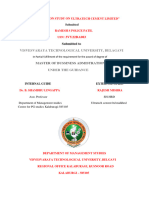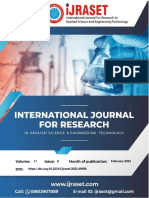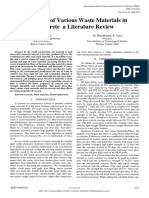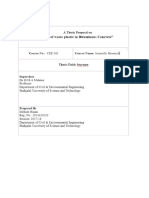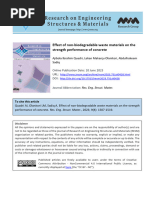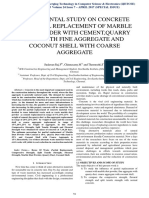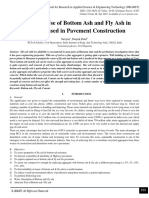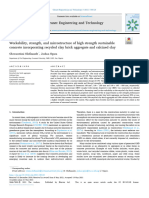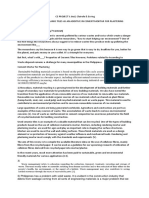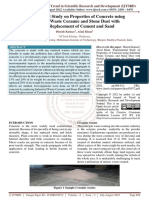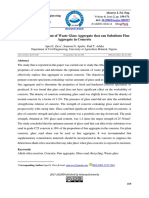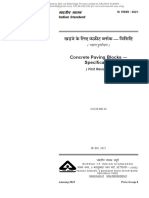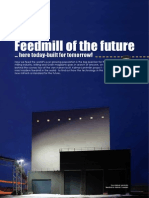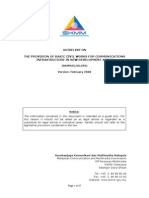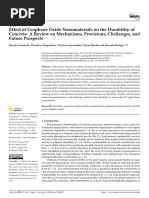HGFDSASDFGH
HGFDSASDFGH
Uploaded by
D For DecoreCopyright:
Available Formats
HGFDSASDFGH
HGFDSASDFGH
Uploaded by
D For DecoreCopyright
Available Formats
Share this document
Did you find this document useful?
Is this content inappropriate?
Copyright:
Available Formats
HGFDSASDFGH
HGFDSASDFGH
Uploaded by
D For DecoreCopyright:
Available Formats
International Journal of Civil Engineering and Technology (IJCIET)
Volume 9, Issue 3, March 2018, pp. 1028–1036, Article ID: IJCIET_09_03_103
Available online at http://www.iaeme.com/ijciet/issues.asp?JType=IJCIET&VType=9&IType=3
ISSN Print: 0976-6308 and ISSN Online: 0976-6316
© IAEME Publication Scopus Indexed
A DETAILED STUDY ON PARTIAL
REPLACEMENT OF FINE AGGREGATE WITH
BRICK DEBRIS
R. Veerakumar
Assistant Professor, Vel Tech Rangarajan Dr. Sagunthala R & D Institute of Science and
Technology, Avadi, Tamilnadu, Chennai, India
R. Saravanakumar
Assistant Professor, Vel Tech Rangarajan Dr. Sagunthala R & D Institute of Science and
Technology, Avadi, Tamilnadu, Chennai, India
ABSTRACT
Concrete is the most material being used in infrastructure development throughout
the world. Fine aggregate is a prime material used for preparation of mortar and
concrete and which plays a major role in mix design. Fine aggregates are weathered
and worn out particles of rocks and are of various grades or sizes depending upon the
amount of wearing. Now-a-days fine aggregate is not readily available, it is
transported from a long distance. Those resources are also exhausting very rapidly.
The non-availability or shortage of fine aggregate will affect the construction
industry, hence there is a need to find the new alternative material to replace the fine
aggregate, such that harm to environment is prevented. Many researchers are finding
different materials to replace fine aggregate. This study aimed to investigate the
suitability of using brick debris in concrete in place of fine aggregate. Brick debris
originated from demolished masonry walls crushed in the laboratory and added in
partial fine aggregate replacement. Four replacement levels, 5%, 10%, 15%, and
20%, were compared with the control. The tests on concrete showed that the
mechanical properties (compressive strength test) of concrete containing brick debris
were well comparable to those of the concrete without ground brick.
Keywords: Compressive strength, Brick debris, Fine aggregate.
Cite this Article: R. Veerakumar and R. Saravanakumar, A Detailed Study on Partial
Replacement of Fine Aggregate with Brick Debris, International Journal of Civil
Engineering and Technology, 9(3), 2018, pp. 1028–1036.
http://www.iaeme.com/IJCIET/issues.asp?JType=IJCIET&VType=9&IType=3
1. INTRODUCTION
Concrete is the mixture of various materials coarse aggregate, fine aggregate, cement &
water, each of them is mixed in various proportions to achieve specific strength (Animesh et
al 2017). Huge quantities of construction and demolition wastes are generated not only in
http://www.iaeme.com/IJCIET/index.asp 1028 editor@iaeme.com
R. Veerakumar and R. Saravanakumar
India but all over the world. These wastes are increasing every year predominantly The annual
concrete production is estimated as 11 billion metric tons, 70–75% of the number is fine
aggregate (mostly natural rock); 15% is water; and 10–15% is cementations binder. With
increasing environmental pressure to reduce solid waste and to recycle as much as possible,
the concrete industry has adopted a number of methods to achieve this goal by replacement
of different waste materials instead of fine aggregate and coarse aggregate (Sharifi et al
2013; Animesh et al 2017). Importantly, the need for fine aggregate also increases rapidly as
the present world is constantly focused on bigger and better infrastructure and the demand for
fine aggregate is enormous.
One of the existing problems is that the increasing use of natural fine aggregate creates an
ecological imbalance as we are constantly extracting from the natural resources. Thus, partial
replacement of fine aggregate is vital in construction industries. Various researchers and
scientists are already working and also have come out with their own ideas to decrease or
fully replace the use of fine aggregate and use recent innovations such as M-Sand
(manufactured sand), robot silica or sand, brick debris, filtered sand, treated and sieved silt
removed from reservoirs as well as dams besides sand from other water bodies Use of
construction debris as fine aggregate is an alternative for the replenishing quarry and river
sand. The present study presents an overview of other efforts for the replacement of fine
aggregate and also to evaluate the utility of crushed brick as a partial replacement of sand in
concrete. Further the replaced concrete material is compared with the performance
conventional concrete. In addition to that, this work helps in understanding the effectiveness
of brick as in strength enhancement.
2. A REVIEW OF ALTERNATE SOURCES FOR REPLACEMENT OF
FINE AGGREGATE
Civil Engineering construction activity is always associated with new development and
projects. This can be a housing project, industrial infrastructure power plants, docks and
harbour works etc., large quantities of traditional construction materials like earth, sand,
stones, bricks, cement concrete, steel, aluminium, wood are used. The demand for these
materials is increasing in geometric progression. Sustainable development means a
commitment to finding and using resources that are renewable. With this philosophy in view,
there is an urgent need for optimum reuse of building waste materials available after
demolition and renewal of old structures. In the recent past, attention has been shifted in
finding alternative sources and materials for the replacement of fine and coarse aggregates.
Many researchers have tried different options from organic materials, herbs, glass materials,
demolition wastes, wooden wastes, plastic wastes, and electronic wastes and so on. It is
worthwhile for exploring the possibilities of application of these materials for further reuse.
Gamashta and Gumashta (2006) examined different properties in reused concrete and
brick masonry waste materials and suggests suitable recommendations for further enhancing
life of structures, thereby resulting in sufficient economy to the cost of buildings.
Muthulakshmi and Nivedhitha (2012) investigated through their experiments to gauge the
effect of partial replacement of natural coarse aggregates (NCA) and natural fine aggregates
(NFA) by recycled coarse aggregates (RCA) and recycled fine aggregates (RFA) on
compressive strength, tensile strength and flexural strength of recycled concrete. 10%, 20%,
30% of NCA and NFA were replaced with RCA and RFA respectively. The results obtained
from compressive strength test, split tensile test and flexural test were compared with the
conventional concrete. From the experimental study, it was observed that compressive
strength & tensile strength of concrete with recycled aggregates increased up to 20%
http://www.iaeme.com/IJCIET/index.asp 1029 editor@iaeme.com
A Detailed Study on Partial Replacement of Fine Aggregate with Brick Debris
replacement of natural aggregates with recycled aggregates whereas the flexural strength of
recycled concrete was found to decrease with increase in percentage of RCA & RFA.
Jayakumar et al 2016 aimed finding the optimum concrete mixture encompassing of cement
mortar and brick bat debris as a substitute for fine aggregate. The basic properties of cement
mortar debris and brick bat debris as fine aggregate was studied and it is compared with the
traditional fine aggregate. It was tried in different proportions on strength and was recorded at
the curing age of 7, 14 and 28 days. The results concluded that particular proportions of
cement mortar debris and brickbat debris displayed enhancing effect on the compressive
strength.
Nili et al 2012 worked on the concrete potential as a friendly environmental construction
material to use different type of waste materials as a partial replacement for aggregates and
even cement. Six type of waste materials include: recycled concrete aggregate (RCA), waste
glass of all kinds mostly (container glass, thin film transistor liquid crystal display [TFT-
LCD], crushed clay brick aggregate, various plastic types such as polyethylene (PET), scraped
PVC pipes and rubbers , recycled ceramic materials from sanitary installation and recycling
ornamental stones (Granite and Marble). For all six categories of recycled materials,
mechanical and durability properties are discussed. Also reuse of these materials in concrete
were evaluated from the viewpoints of environmental aspect and cost efficiency. It is
concluded that by introducing of some outstanding features of these materials, a new
perspectives to concrete technology and efficiently may be expected.
Sriharsha and Murthy (2014) utilized demolition debris from old structures of
construction industries and the blast furnace slag which is easily available from iron ore
industries for manufacturing the test samples in various batch mix proportions with 53 grade
cement; providing a stage for further research in this aspect, using the feasible results from
experimental studies, in order to manufacture test blocks or bricks as practicable. Laboratory
tests are carried out to assess the physical properties like compression strength and water
absorption on these test samples. The strength characteristics of all the above samples with
standard mixes and modified proportions are studied. The compressive strength and water
absorption are calculated for each sample and are compared with each mix and conclusions
are drawn.
Kumar and Siva (2015) carried out laboratory experiments to scrutinize a concrete made
of partial replacement of coarse aggregate with construction and demolition waste materials
like ceramic tiles waste, plastic debris, crushed bricks. The resultant concrete thus produced
was tested on the following parameters like compressive strength, workability, flexural
strength. The results thus obtained are compared with a plain cement concrete. By using low
weight materials like plastic debris they got a light weight concrete. The workability of
concrete produced with construction waste when compared with plain cement concrete is not
reliable but it produced a considerable increase in the compressive strength.
Dinesh Kumar et al 2016 focused on the usage of coal bottom ash in replacing the fine
aggregate. Bottom ash forms up to 25% of the total ash while the fly ash forms the remaining
75%. Their research experimented the behaviour of concrete using coal bottom ash at
different replacement level of sand. The study evaluated the potential of coal bottom ash as a
partial replacement of sand in concrete by 0% , 10% , 20% , 30%, 40%, and 50% . In order to
study the mechanical properties of concrete, M25 grade was fixed. At the point when the
bottom ash is utilized as a part of the concrete, the workability of existing is diminished
because of the water request. At last, the utilization of coal bottom ash in concrete is
http://www.iaeme.com/IJCIET/index.asp 1030 editor@iaeme.com
R. Veerakumar and R. Saravanakumar
prescribed as a different option for fine aggregates in concrete but limited to 20% by weight
of fine aggregate.
Sai Samanth and Prakhar (2016) dealt with the analysis of properties of concrete replaced
by recycled construction and demolition debris as aggregates in concrete mix. Determining
the replacement ratio of this debris as fine and coarse aggregate is presented in this paper with
experimental results. This effective utilization of the debris as aggregates without altering the
properties of conventional concrete contributes in solid waste management and also helps in
finding partial replacement for sand and quarry.
Based on the literature review, the present research work focusses on the demolished
bricks as an alternate source. As bricks are wasted during the demolition of some construction
site in some sites it is being used as a replacement of coarse aggregate. In India about 30% of
construction is being done on the demolition site where most of the waste construction is
wasted. Such waste construction material can be used as replacement in making concrete
blocks.
3. MATERIALS AND METHODS
Concrete is prepared by mixing various constituents like cement, aggregates, water etc. which
are economically available. Ordinary Portland cement of 53 grade was used throughout the
work. The fine aggregate used in this investigation was clean river sand, whose maximum
size is 4.75 mm, conforming to grading zone II. The properties of the materials are presented
in Table 1.
Table 1 Properties of the constituent materials
OPC Brick
No. Parameter Fine Aggregate Coarse Aggregate
used Debris
1. Normal Consistency 29% -- -- --
2. Initial Setting Time (minutes) 45 -- -- --
3. Final Setting Time(minutes) 240 -- -- --
4. Specific Gravity 3.15 2.00 2.45 --
5. Bulk density -- 975 1135 1169
6. Fineness modulus -- 3.76 4.62 --
7. Water Absorption -- 5.26% 2.04% --
8. Apparent specific gravity -- 2.23 2.57 --
9. % of Voids -- 112.99% 55.02% 154.65%
Bricks crushed in coarse powder form were used as a fine aggregate for making concrete.
The waste bricks as obtained from garbage of a broken building were collected and pulverized
to get the particle passing 4.75 mm sieve and retained on 0.075 mm sieve to get the grading of
fine aggregate. 5, 10, 15, and 20% brick powder is used as replacement of fine aggregate in
the experiments.
The aim of the experiment was to assess the properties of concrete made with crushed
brick and to study important aspects such as compressive strength of concrete prepared by
using brick debris with different percentage of replacements with Fine Aggregate. The
concrete mix design was proposed using Indian Standard for control concrete (IS
10262:1982). The grade was M20. The Proportion of materials shown in Table 2. The
replacement levels of sand by brick powder were used in terms of 5%, 10%, 15%, and 20% in
concrete.
http://www.iaeme.com/IJCIET/index.asp 1031 editor@iaeme.com
A Detailed Study on Partial Replacement of Fine Aggregate with Brick Debris
Table 2 Mix proportion
No. Ingredients Kg/m3 Proportion
1. Ordinary Portland Cement 383
2. Fine Aggregate 546 1:1.5:3 W/C = 0.5
3. Coarse Aggregate 1187
Cement used for the study was tested for the parameters specific gravity, fineness,
consistency test, setting time. Fine aggregate were tested for Fineness modulus, specific
gravity, Water absorption, Bulk density, Void ratio. Concrete blocks were tested for
compressive strength under four different mixes. In CC mix, the conventionally Cement,
Coarse aggregate, Fine Aggregate were mixed with Water and analysed for strength
parameters. In R-1 mix only 5% Fine Aggregate is replaced with brick debris and other
ingredients were as same in CC mix. In R-2 mix only 10% Fine Aggregate is replaced with
brick debris and other ingredients were as same in CC mix. In R-3 mix only 15% Fine
Aggregate is replaced with brick debris and other ingredients as same in CC mix. In R-4 only
20% Fine Aggregate is replaced with brick debris and other ingredients were as same in CC
mix.
In order to study the effect of replacement of sand in various ratio of brick debris 12
numbers of cube of 150mm x150mm x 150mm size were cast and used as test specimens to
determine the compressive strength at the age of 7,14 and 28 days. All specimens were tested
every time at the required days and mean value was taken. Sieve analysis (IS 2386-PART I)
was carried out on the river sand, cement mortar debris and brick bat debris as shown in
Table 3 and Table 4.
Table 3 Gradation analysis of the fine aggregate
Sieve size Weight of Aggregate Weight retained Cumulative % Percentage
No.
retained (%) weight retained passing (%)
1. 4.75 0 0 0 100
2. 2.36 10 10 1 99.0
3. 1.18 215 225 22.5 77.5
4. 500µ 385 610 61.0 39.0
5. 300µ 215 825 82.5 17.5
6. 150µ 140 965 96.5 3.5
7. 75µ 25 990 99.0 1
8. pan 10 1000 100.0 --
120
100
80
60
Series1
40
20
0
0.01 0.1 1 10
Graph 1 Sieve analysis graph for fine aggregate
http://www.iaeme.com/IJCIET/index.asp 1032 editor@iaeme.com
R. Veerakumar and R. Saravanakumar
Table 4 Gradation analysis of the brick debris
Weight of Weight
Sieve size Cumulative % Percentage
No. Aggregate retained
weight retained passing (%)
retained (%)
1. 4.75 0 0 0 100
2. 2.36 40 40 4.0 96.0
3. 1.18 125 165 16.5 83.5
4. 500µ 175 340 34.0 66.0
5. 300µ 155 495 49.5 50.5
6. 150µ 290 785 78.5 21.5
7. 75µ 155 940 94.0 6
8. Pan 10 1000 100.0 --
120
100
80
60
Series1
40
20
0
0.01 0.1 1 10
Graph 2 Sieve analysis graph for brick debris
4. EXPERIMENTAL OBSERVATIONS
The casted cubes were tested for compressive strength at 7, 4 and 28 days of curing. The
compressive strength values of 7, 14 and 28 days were obtained and are listed in the following
Table 6, Table 7 and Table 8 respectively.
Table 6 Compressive strength values for 7 days
Compressive
Mix % of Weight Load
No. Days Area mm2 strength
brick debris kg kN
N/mm2
1 Normal 7 150x150 8.100 520 23.11
2 5% 7 150x150 8.025 615 27.33
3 10% 7 150x150 8.086 596 26.49
4 15% 7 150x150 7.910 535 23.78
5 20% 7 150x150 7.865 484 21.51
http://www.iaeme.com/IJCIET/index.asp 1033 editor@iaeme.com
A Detailed Study on Partial Replacement of Fine Aggregate with Brick Debris
Table 7 Compressive strength values for 14 days
Mix % of Max Load Compressive strength
No. Days Area mm2 Weight kg
brick debris kN N/mm2
1 Normal 14 150x150 8.250 627 27.87
2 5% 14 150x150 7.930 807 35.87
3 10% 14 150x150 7.810 878 39.02
4 15% 14 150x150 8.210 664 29.51
5 20% 14 150x150 7.950 680 30.22
Table 8 Compressive strength values for 28 days
Mix % of brick Compressive
No. Days Area mm2 Weight kg Load kN
debris strength N/mm2
1 Normal 28 150x150 7.925 508 22.57
2 5% 28 150x150 7.345 561 24.93
3 10% 28 150x150 8.355 564 25.06
4 15% 28 150x150 8.060 448 19.91
5 20% 28 150x150 7.405 474 21.06
5. RESULTS AND DISCUSSIONS
The experimental investigations carried out in the laboratory to determine the strength
properties of the concrete with the additional mixture of crushed brick and test results are
discussed. As per design obtained in accordance to code IS-10262, mix proportion of
various materials (viz. Cement, Coarse Aggregate, Fine Aggregate and Water) is
calculated for M-20 grade of concrete. The cubes were casted and tested in the
laboratory. The results of compressive strength of cubes for 7, 14 and 28 days for
various mixes are compared and presented in Figure 1. The compressive strength for
5% 10%, 15% and 20% replacement of Fine Aggregate by brick debris were compared
with conventional/Natural concrete.
Figure 1 Comparison of Compressive strength for various proportions of brick debris @ 7, 14 and 28 days
http://www.iaeme.com/IJCIET/index.asp 1034 editor@iaeme.com
R. Veerakumar and R. Saravanakumar
Out of all tests conducted on concrete, compressive strength of concrete has utmost
importance and which gives all the important characteristics of a concrete. We have casted a
total of 12 concrete blocks with different proportions including OPC. Size of the concrete
block 150mm×150mm×150mm cube moulds are used for the tests. The concrete is poured in
to mould and are tampered to avoid voids. After hours of duration test moulds are removed
and the specimens are kept in water for curing. These specimens are tested under compressive
testing machine after 7 days, 14 days and 28 days after casting.
6. CONCLUSIONS
Based on the experimental study of investigating the use of brick debris in concrete, the
following conclusions which are limited to the materials used in the study.
This is an eco-friendly concrete as it subsides the stagnation of demolished brick waste by
consuming it.
As much as of the total cost of cement in conventional method can be saved by this procedure.
Cost saving percentage increases with increase in richness of mix design.
Concrete gains early strength and hence shuttering can be removed early thereby reducing the
secondary overhead copy.
The test results of compressive strength shows that the optimum replacement of fine aggregate
is achieved at 10% replacement of fine aggregate by crushed brick debris compared to the
respective conventional concrete strength.
The possibility exists for the partial replacement of fine aggregate with brick debris which is
produced during demolition of construction site.
Also other industrial and agro-waste materials can be appropriately utilized in civil
construction works. Therefore, the economic viability of such applications along with the
durability of these materials needs further examination. An important obvious advantage is
that with recycling of stone, aggregate, bricks etc. quarrying and mining for stones, and will
be reduced. Thus the earth surface can be further saved and ecological disturbances on
account of this activity will be reduced. For example, raw material for bricks manufacturing is
totally earth based. Reuse of bricks means lesser possibilities of removing fertile earth, soil
grass cover and forestation. This will minimize environmental destruction in over all terms.
With large volume of building works, and to meet its demand, it is observed that there can be
large uncontrolled growth of brick kilns, contributing to environmental decay.
REFERENCES
[1] Animesh, K. Tiwari, J. Soni, K. A Review of Partial Replacement of Fine Aggregate &
Coarse Aggregate by Waste Glass Powder & Coconut Shell. International Research
Journal of Engineering and Technology. 4(10), 2017, pp 187-190.
[2] Sharifi, Y. Houshiar, M. Aghebati, B. Recycled Glass Replacement as Fine Aggregate in
Self-compacting Concrete. Frontiers of Structural and Civil Engineering. 7(4), 2013, pp
419-428.
[3] Muthu Lakshmi, S. Nivedhitha, R.R. Efffect of Partial Replacement of Aggregates by
Recycled Concrete Debris on Strength of Concrete. Malaysian Journal of Civil
Engineering. 27(2), 2015, pp 250-259.
[4] Dinesh Kumar, G. Mohiuddin, M.Y. Haleem, M.A. An Experimental Study on Partial
Replacement Fine Aggregate with Coal Bottom Ash in Concrete. International Journal of
Research Sciences and Advanced Engineering. 2(15), 2016, pp 39-49.
http://www.iaeme.com/IJCIET/index.asp 1035 editor@iaeme.com
A Detailed Study on Partial Replacement of Fine Aggregate with Brick Debris
[5] Nili, M. Biglarijoo, N. Mirbagheri, S.A. A Review on the Use of Various Kinds of Debris
and Demolitions in Concrete and Mortar Mixes. 10th International Congress on Advances
in Civil Engineering. 17-19 October 2012 Middle East Technical University, Ankara,
Turkey.
[6] Sai Samanth, A, Prakhar. Study of Strength Properties of Concrete with Construction
Debris as Aggregates. International Journal of Engineering Research in Mechanical and
Civil Engineering. 1(5), 2016, pp 42-45.
[7] Gamashta, L. Gumashta, S. Reuse of Concrete and Masonry Waste Materials in
Construction to Minimize Environmental Damages due to Quarrying. Journal of
Environmental Researh and Development. 1(1), 2006, pp 65-67.
[8] Kumar, N.S.T. Siva, C. Use of Construction Renovation and Demolition Waste in Partial
Replacement of Coarse Aggregate in M20 Concrete. International Journal of Research in
Engineering and Technology. 4(10), 2015, pp 375-378.
[9] Shriharsha, Murthy S.N. Alternative building materials using fine ground granulated blast
furnace slag and fine demolition debris. International Journal of Renewable Energy and
Environmental Engineering. 2(2), 2014, pp 86-88.
http://www.iaeme.com/IJCIET/index.asp 1036 editor@iaeme.com
You might also like
- Project Report On Ultratech Cement Limited PDFDocument45 pagesProject Report On Ultratech Cement Limited PDFRamesh PatilNo ratings yet
- FGHJKJHGFDSDocument10 pagesFGHJKJHGFDSD For DecoreNo ratings yet
- A Review Paper On Replacement of Fine AggregateDocument5 pagesA Review Paper On Replacement of Fine AggregateIJRASETPublicationsNo ratings yet
- Editorirjmt, IRJMT 68 Paper EditDocument6 pagesEditorirjmt, IRJMT 68 Paper EditgunaNo ratings yet
- An Experimental Study On Partial Replacement of Sand With Crushed Brick in ConcreteDocument7 pagesAn Experimental Study On Partial Replacement of Sand With Crushed Brick in ConcreteIJSTE100% (1)
- Improving Strength of Concrete Using Crushed Tiles and Nylon FiberDocument16 pagesImproving Strength of Concrete Using Crushed Tiles and Nylon FiberIJRASETPublicationsNo ratings yet
- RRLDocument8 pagesRRLone hundredNo ratings yet
- Chapter 2 - Conceptual Framework Review of Related Literature and StudiesDocument8 pagesChapter 2 - Conceptual Framework Review of Related Literature and StudiesraifelNo ratings yet
- 3578-10110-1-PBDocument18 pages3578-10110-1-PBSACHINNo ratings yet
- Experimental Investigation On Reinforced Concrete With Plastic FiberDocument6 pagesExperimental Investigation On Reinforced Concrete With Plastic FiberIJRASETPublicationsNo ratings yet
- Utilization of Various Waste Materials in Concrete A Literature ReviewDocument6 pagesUtilization of Various Waste Materials in Concrete A Literature ReviewmulualemNo ratings yet
- Utilization of Various Waste Materials in Concrete A Literature ReviewDocument5 pagesUtilization of Various Waste Materials in Concrete A Literature ReviewYasemin PurtaşNo ratings yet
- A Review Paper On Strength and Durability Studies On Concrete Fine Aggregate Replaced With Recycled Crushed GlassDocument4 pagesA Review Paper On Strength and Durability Studies On Concrete Fine Aggregate Replaced With Recycled Crushed GlassIAEME PublicationNo ratings yet
- Thesis Chapter 1Document4 pagesThesis Chapter 1jeanvnrcnNo ratings yet
- Effect of Waste Material On Properties oDocument14 pagesEffect of Waste Material On Properties oChidi OkoloNo ratings yet
- Thesis ProposalDocument7 pagesThesis ProposalMEHIDE HASANNo ratings yet
- Modeling of Strength of Concrete Produced With Fine Aggregates From Different SourcesDocument13 pagesModeling of Strength of Concrete Produced With Fine Aggregates From Different SourcesEmmanuel OgunjioforNo ratings yet
- Recycling of Wastes For Value-Added Applications in Concrete Blocks - An OverviewDocument15 pagesRecycling of Wastes For Value-Added Applications in Concrete Blocks - An OverviewSamuel Marcelo Villarroel CarcamoNo ratings yet
- M5 NEMT Ta 1Document9 pagesM5 NEMT Ta 1Atharv ChoudhariNo ratings yet
- Evaluation of Mechanical Properties and Structural Behaviour of Concrete Pavements Produced With Virgin and Recycled Aggregates An Experimental andDocument16 pagesEvaluation of Mechanical Properties and Structural Behaviour of Concrete Pavements Produced With Virgin and Recycled Aggregates An Experimental andCivil manNo ratings yet
- A Review of Eco Friendly Blocks ProductiDocument6 pagesA Review of Eco Friendly Blocks Productikabeer1210No ratings yet
- IJETR2833Document7 pagesIJETR2833Harsh ChordiyaNo ratings yet
- A Review On Use of Waste Tyre in Cement Concrete Pavement by Replacing Coarse AggregatesDocument5 pagesA Review On Use of Waste Tyre in Cement Concrete Pavement by Replacing Coarse AggregatesEditor IJTSRDNo ratings yet
- Experimental Investigation of Waste Plastic Fiber in Reinforced Cement Concrete Using Recycled Coarse AggregateDocument12 pagesExperimental Investigation of Waste Plastic Fiber in Reinforced Cement Concrete Using Recycled Coarse AggregateInternational Journal of Application or Innovation in Engineering & ManagementNo ratings yet
- Concrete Using Recycled AggregatesDocument35 pagesConcrete Using Recycled AggregatesEpherem DanielNo ratings yet
- Recycled Aggregate Concrete For Transportation InfrastructureDocument10 pagesRecycled Aggregate Concrete For Transportation InfrastructureKan BunsamranjitNo ratings yet
- Research Paper Partial Replacement of Coarse Aggregate in Concrete With Waste Ceramic TilesDocument9 pagesResearch Paper Partial Replacement of Coarse Aggregate in Concrete With Waste Ceramic TileshammadNo ratings yet
- Ijems 21 (4) 451-457 PDFDocument7 pagesIjems 21 (4) 451-457 PDFPtpgStucNo ratings yet
- An Experimental Investigation On Mechanical Properties of Concrete by Partial Replacement of Cement With Wood Ash and Fine Sea Shell PowderDocument6 pagesAn Experimental Investigation On Mechanical Properties of Concrete by Partial Replacement of Cement With Wood Ash and Fine Sea Shell PowderEphremMelakuNo ratings yet
- Light Weight ConcreteDocument14 pagesLight Weight Concreteshahtanveer1999No ratings yet
- Review On Partial Replacement of Cement in ConcretDocument6 pagesReview On Partial Replacement of Cement in ConcretElmeerajh JudavarNo ratings yet
- Effect of Non-Biodegradable Waste Materials On The Strength Performance of ConcreteDocument14 pagesEffect of Non-Biodegradable Waste Materials On The Strength Performance of ConcreteRAHULNo ratings yet
- Use of SCC and Rca For Sustainable ConstructionDocument5 pagesUse of SCC and Rca For Sustainable ConstructionesatjournalsNo ratings yet
- 346experimental Study On Concrete by Partial Replacement of Marble Dust Powder With Cement Quarry Dust With Fine PDFDocument5 pages346experimental Study On Concrete by Partial Replacement of Marble Dust Powder With Cement Quarry Dust With Fine PDFMichael ShioNo ratings yet
- New PPT 1 Rubber WasteDocument16 pagesNew PPT 1 Rubber WasteStark Azim67% (6)
- 2-25062015 Fly Ash Concrete Has Economical and Environmental Advantages Traa PDFDocument4 pages2-25062015 Fly Ash Concrete Has Economical and Environmental Advantages Traa PDFrendaninNo ratings yet
- Chap 1Document3 pagesChap 1emmanuelezekulie2No ratings yet
- A Study On Use of Bottom Ash and Fly Ash in Concrete Used in Pavement ConstructionDocument11 pagesA Study On Use of Bottom Ash and Fly Ash in Concrete Used in Pavement ConstructionIJRASETPublications100% (1)
- Utilization of Sawdust in Making Concrete Blocks: An Experimental Research On Hollow Concrete Block's RigidityDocument10 pagesUtilization of Sawdust in Making Concrete Blocks: An Experimental Research On Hollow Concrete Block's RigidityJoefil Carl DacorroNo ratings yet
- Use of Glass Powder For Soil StabilisationDocument75 pagesUse of Glass Powder For Soil StabilisationKaushal RijalNo ratings yet
- ZA051105162166Document5 pagesZA051105162166Nihal SinghNo ratings yet
- Experimental Study On Blended Concrete in R.C.C Beam and Its Behaviour Phase-Ii Review-1Document17 pagesExperimental Study On Blended Concrete in R.C.C Beam and Its Behaviour Phase-Ii Review-1HemapriyaNo ratings yet
- Effect of Granite Dust & M-Sand On Strength Properties of Conventional ConcreteDocument11 pagesEffect of Granite Dust & M-Sand On Strength Properties of Conventional ConcreteDulguunkherlen BudkhandNo ratings yet
- 2Document7 pages2Ar Vishul SaxenaNo ratings yet
- An Experimental Study On Concrete Strength Optimization With Surkhi As An Eco-Friendly Sand SubstituteDocument13 pagesAn Experimental Study On Concrete Strength Optimization With Surkhi As An Eco-Friendly Sand SubstituteInternational Journal of Innovative Science and Research TechnologyNo ratings yet
- 1 s2.0 S2666790821000835 MainDocument10 pages1 s2.0 S2666790821000835 MainIndriani MandalikaNo ratings yet
- DFGHJKLDocument5 pagesDFGHJKLD For DecoreNo ratings yet
- Experimental Study On Behaviour of Concrete by Using Silica Fume and Saw Dust in ConcreteDocument9 pagesExperimental Study On Behaviour of Concrete by Using Silica Fume and Saw Dust in ConcreteIJRASETPublicationsNo ratings yet
- Irjet V7i4845Document9 pagesIrjet V7i4845N SanthoshNo ratings yet
- Effect of Steel Fibers On Compressive Strength of Recycled Aggregate ConcreteDocument8 pagesEffect of Steel Fibers On Compressive Strength of Recycled Aggregate ConcreteMateusz OrłowskiNo ratings yet
- Journal Printabs 4haug14esrDocument11 pagesJournal Printabs 4haug14esrBruno CarleteNo ratings yet
- Background of The Study (Why? Context)Document8 pagesBackground of The Study (Why? Context)Clairole Marie QuilantangNo ratings yet
- Performance of High-Strength Concrete Made With Recycled Ceramic AggregatesDocument10 pagesPerformance of High-Strength Concrete Made With Recycled Ceramic AggregatesJoão Felipe João F.No ratings yet
- Mix Design for Pervious Recycled Aggregate ConcretDocument9 pagesMix Design for Pervious Recycled Aggregate ConcrethaamrofoundationNo ratings yet
- Experimental Study On Properties of Concrete Using Industrial Waste Ceramic and Stone Dust With Partial Replacement of Cement and SandDocument4 pagesExperimental Study On Properties of Concrete Using Industrial Waste Ceramic and Stone Dust With Partial Replacement of Cement and SandEditor IJTSRDNo ratings yet
- Study On The Replacement of Construction & Demolition Waste Materials As Fine Aggregates in The Production of Low Strength ConcreteDocument8 pagesStudy On The Replacement of Construction & Demolition Waste Materials As Fine Aggregates in The Production of Low Strength ConcreteIJRASETPublications100% (1)
- Development of Coconut Shell Waste BasedDocument5 pagesDevelopment of Coconut Shell Waste BasedSoham KatviNo ratings yet
- The Optimum Amount of Waste Glass Aggregate That Can Substitute FineDocument13 pagesThe Optimum Amount of Waste Glass Aggregate That Can Substitute FineAper ZavaNo ratings yet
- Kaptan SinghqLbEDocument4 pagesKaptan SinghqLbENihal SinghNo ratings yet
- Enhanced Concrete PropertiesDocument16 pagesEnhanced Concrete PropertiesMohammad KhorsandNo ratings yet
- Sustainability in Structural Concrete DesignFrom EverandSustainability in Structural Concrete DesignJorge de BritoNo ratings yet
- Bill of Quantities (Boq) - NepalDocument7 pagesBill of Quantities (Boq) - NepalHamza Mami50% (2)
- Guide To Inspection & Maintenance of RCCDocument16 pagesGuide To Inspection & Maintenance of RCCRahul NampalliwarNo ratings yet
- Sikalastic®-590: Product Data SheetDocument5 pagesSikalastic®-590: Product Data SheetBrian BryanNo ratings yet
- 2021 Annex C &DDocument24 pages2021 Annex C &DSaurav Kumar100% (1)
- Feedmill of The FutureDocument14 pagesFeedmill of The FutureMilling and Grain magazineNo ratings yet
- Contenedor Vacío / Pesado y OGG: CCCC Water Transportation Consultants Co - LTDDocument1 pageContenedor Vacío / Pesado y OGG: CCCC Water Transportation Consultants Co - LTDJoel MontoyaNo ratings yet
- Arch Dam Design - U.S. Army Corps of Engineers-Part ADocument120 pagesArch Dam Design - U.S. Army Corps of Engineers-Part AhafizrahimmitNo ratings yet
- SKMM Comm Infra GuidelinesDocument37 pagesSKMM Comm Infra GuidelinescloobpspNo ratings yet
- An Investigation On Design Procedure and Operations of Polymer Fibre Reinforced Concrete Pavements by S. Panda & N.H.S.rayDocument12 pagesAn Investigation On Design Procedure and Operations of Polymer Fibre Reinforced Concrete Pavements by S. Panda & N.H.S.rayijr_journalNo ratings yet
- 2 Introduction RCDocument22 pages2 Introduction RCHundeejireenyaNo ratings yet
- Bill of Quantities-TenderDocument12 pagesBill of Quantities-TenderbhartiNo ratings yet
- 9 Standards and Specs - 1Document16 pages9 Standards and Specs - 1Mutundisavakadzi G-spot LocatorNo ratings yet
- KilnOpBasics - ManufProcess OverviewDocument31 pagesKilnOpBasics - ManufProcess Overviewmustaf100% (1)
- ResearchDocument25 pagesResearchJenny ValderramaNo ratings yet
- Prediction of Compressive Strength of Fly Ash-Based GeopolymerDocument16 pagesPrediction of Compressive Strength of Fly Ash-Based GeopolymerCh Dawood GujjarNo ratings yet
- Experiment 05Document4 pagesExperiment 05rtawie4809No ratings yet
- Design of Revesing Concrete MixerDocument80 pagesDesign of Revesing Concrete MixerKirubel MogesNo ratings yet
- Renderoc LA55Document2 pagesRenderoc LA55Mansoor AliNo ratings yet
- Recent Advances in Earthquake Resistant Construction PracticesDocument13 pagesRecent Advances in Earthquake Resistant Construction PracticesBenmark JabayNo ratings yet
- CPD 2015121Document60 pagesCPD 2015121Benny LinNo ratings yet
- Materials: Stiffening Performance of Cold-Formed C-Section Beam Filled With Lightweight-Recycled Concrete MixtureDocument23 pagesMaterials: Stiffening Performance of Cold-Formed C-Section Beam Filled With Lightweight-Recycled Concrete MixturecenasNo ratings yet
- Mapei Bassengsystemer 0320 Eksklusiveprodukter en GB 180320 LowDocument28 pagesMapei Bassengsystemer 0320 Eksklusiveprodukter en GB 180320 LowMalak HindiNo ratings yet
- DSR Civil 2016Document717 pagesDSR Civil 2016mohit bhardwajNo ratings yet
- Is 458 2003Document39 pagesIs 458 2003somnathjoy100% (1)
- TDS Weberfloor HardexDocument2 pagesTDS Weberfloor HardexMaha MuflehNo ratings yet
- Con AprilDocument4 pagesCon AprilCha AkpNo ratings yet
- Inbuild NAHB Type Cost CodesDocument9 pagesInbuild NAHB Type Cost CodesRandallNo ratings yet
- Materials 17 02411Document23 pagesMaterials 17 02411praveenm.phdseNo ratings yet
